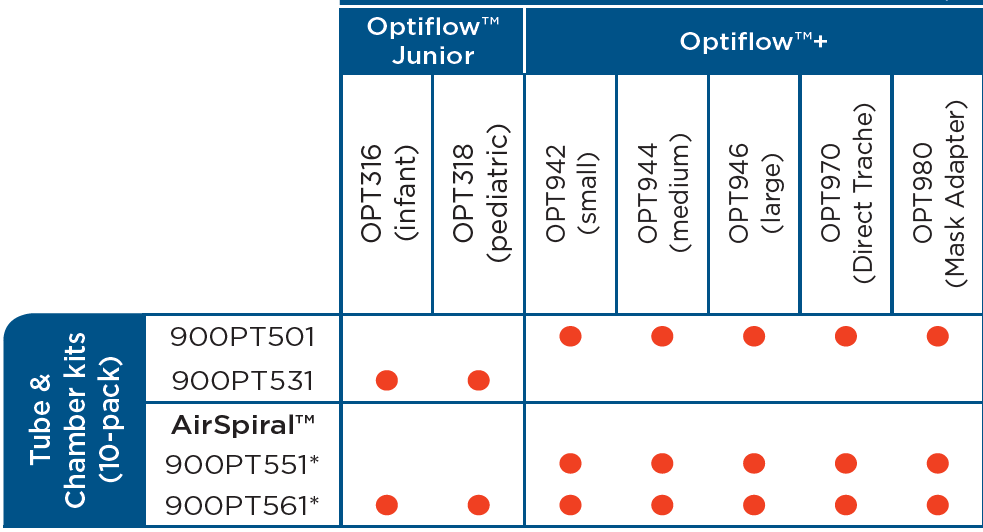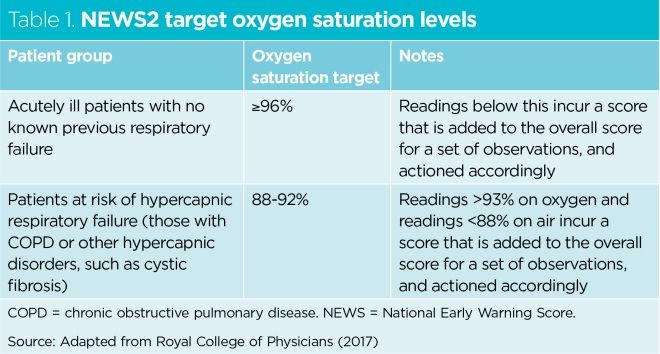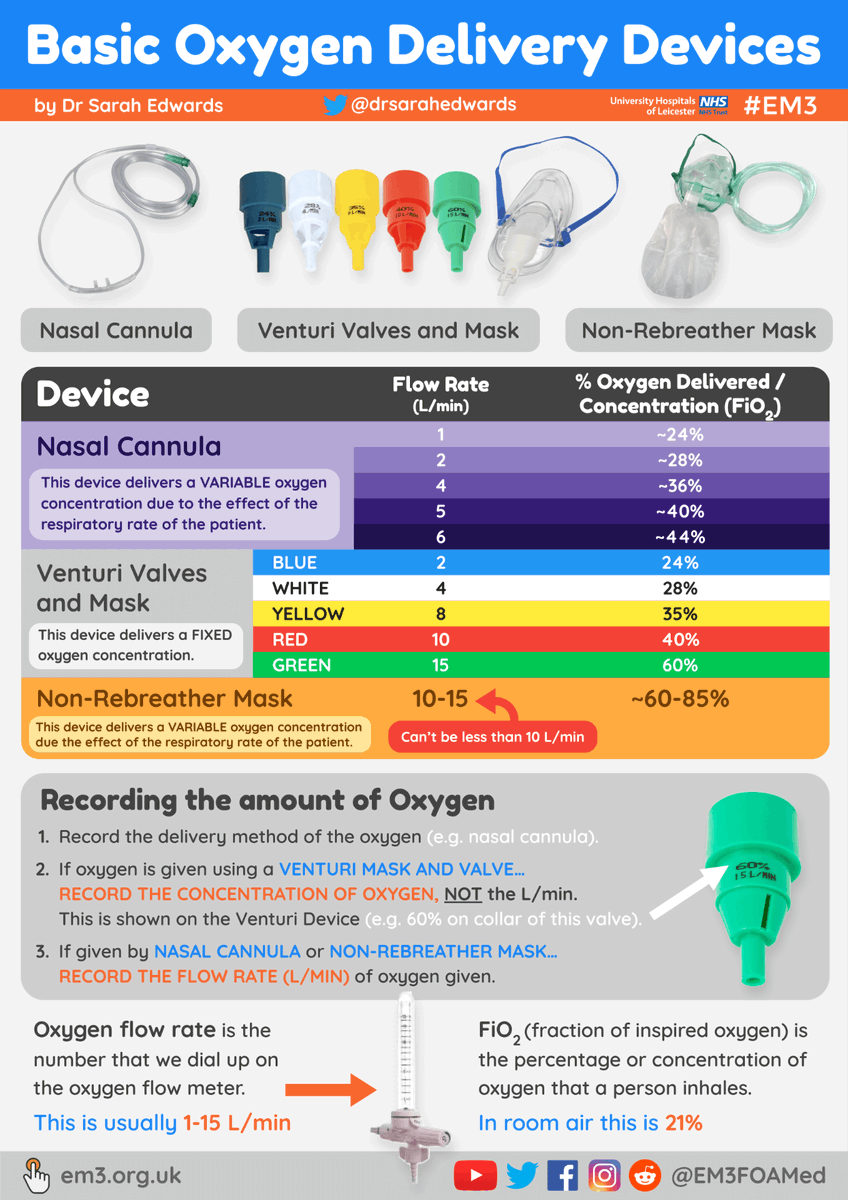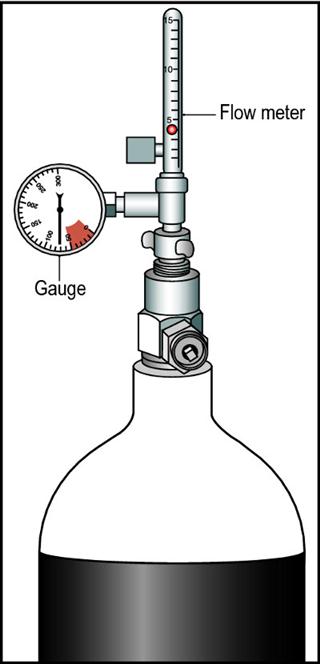oxygen delivery devices and flow rates uk
Ad Call Now Speak To A Respiratory Specialist See Which Medical Oxygen Unit Is Best For You. It is NOT the Lmin stated on the venturi that is delivered to the patient.

Oxymask Versus Traditional Oxygen Devices Download Table
Ensure adequate clearance of secretions and limit the adverse events of hypothermia and insensible water loss by use of optimal humidification dependent on mode of oxygen.

. Same as Salter with added benefit of providing higher flow rate and. In these situations supplemental oxygen can be administered via various oxygen delivery devices ranging from nasal prongs to invasive ventilation. Low flow O2 delivery device 05-6 Lmin.
Oxygen delivery devices and flow rates should be adjusted to keep the oxygen saturation in the target range. Delivers unpredictable oxygen concentrations between 22-35 that vary with flow rate and respiratory pattern and rate. These devices deliver a variable inspired oxygen concentration to the patient which depends on the PIFR.
Dont Pay Retail For Medical Oxygen. These devices deliver a variable inspired oxygen concentration to the patient which depends on the PIFR. High Flow Nasal Cannula.
It is used for the application of heated and humidified blended air and oxygen at high flow rates typically set between 30 lmin and 50 lmin. A 28 valve will have a smaller hole than a 40 valve and so on. 10-15 Lmin 80-90 both flaps removed results in lower 80-85.
This video - produced by students at Oxford University Medical School in conjunction with the faculty - demonstrates how to deliver oxygen therapy through va. Nasal Cannula 1 5 6 Liters per Minute. Venturi masks are high flow delivery devices.
These low flow Oxygen Delivery Devices are variable performance devices ie their performance is effected by changes in patients tidal volume and respiratory rate. Flow rate and FiO2 ranges for simple face mask. Call To Speak To A Respiratory Specialist Today.
A pressure reading barometer. Very commonly used among the Oxygen Delivery Devices in wards. 2 flow rates of less than 2 L O 2 lmin or if minute ventilation is very high 4 Lmin of oxygen flow delivers an FiO 2 of about 03504 providing there is a normal respiratory pattern Flow rates.
Devices such as OxLife Independence Philips SimplyGo Caire SeQual Eclipse 5 and DeVilbiss iGo are all world-class dual-purpose oxygen concentrators that offer a combination. Higher flows 4 Lmin make it uncomfortable for the patient. Deliver oxygen to paents.
Terms in this set 8 1-6 Lmin. The variable performance devices were tested at oxygen flow rates of 2 4 6 8 10 and 15 lmin 1 as delivered by an AHE ball flow meter. Flow rate and FiO2 ranges for nasal cannula.
They have valves which deliver a fixed concentration of oxygen eg. Flow rates of 2-4 litresmin are normally used. The percentage of oxygen inspired depends on the flow rate and the delivery device.
2 A simple face mask is a low-flow oxygen device. 26Lmin gives approx 2450 FIO2 FIO2 depends on oxygen flow and paents minute. Prompt clinical assessment is required if oxygen therapy needs to be initiated or increased due to a falling saturation level.
Venturi valves deliver the following fixed. Also known as Mary Carterall mask. This oxygen tank duration chart shows approximate usage times for most Oxygen Tank sizes.
Simple Oxygen Face mask. High-flow oxygen therapy is applied with a special binasal high-flow nasal cannula HFNC and a heated inspiratory breathing circuit. Different oxygen flow rates result in a highly variable and unpredictable FiO 2 Rebreathing of CO 2 can occur with O 2 flow rates of less than 2 L O 2 lmin or if minute ventilation is very high 4 Lmin of oxygen flow delivers an FiO 2 of about 03504 providing there is.
34 of UK ambulance journeys in 2007 involved oxygen use4 This translated to about two million instances. For example patients commonly use a flow rate of 2 liters per minute but the flow rate varies by each patients needs. Oxygen delivery devices and flow rates emt Get link.
The NC can deliver an inspiratory oxygen fraction FIO2 of 24-40 at supply flows ranging from 1-5. 200969111 Bailey P Thomsen GE Spuhler VJ et alCrit Care MedJan2007351139145. A flow rate of 2 liters per minute increases the FiO2 from 21 percent room air to 28 percent.
The fixed performance devices were assessed using the oxygen flow rates for the appropriate inserts as. The oxygen concentrators pulse-flow. Each valve is colour coded Figure 3 although newer valves can be set at the desired FiO2 in a single unit.
Give oxygen therapy in a way which prevents excessive CO 2 accumulation - ie. The HFNC is an oxygen-delivery system that includes an airoxygen blender humidifier heater and nasal cannula to deliver precise and very high flow oxygen to your patient. High capacity oxygen delivery device High capacity oxygen delivery devices capacity 250-1500 ml With these devices O 2 flows directly into the reservoir bag which fills whenever the patients inspiratory flow rate is lower than the flow rate of delivered O 2The patient thus inhales O 2 preferentially from the reservoir bag and ambient air is not entrained avoiding dilution of.
Reduce the work of breathing. Nasal Cannulae Recommended in the Guideline as suitable for most paBents with both type I and II respiratory failure. Simple oxygen face masks are single patient use and are low-flow masks which entrain the.
Tube with a mask or nasal cannula. The flow rate is how many liters of oxygen per minute your device delivers. Can be used in patients with stable Type II respiratory failure.
Oxygen delivery devices and flow rates should be. High-flow oxygen therapy for spontaneously breathing patients. The oxygen flow rate and the FiO2.
Selection of the appropriate flow rate and delivery device. Oxygen delivery by TTOC bypasses the anatomical dead space in the upper airways and mouth allowing. When the tap is manually opened the oxygen takes the line of least resistance to the patient via an oxygen delivery device eg.
Designed to entrain a set amount of O2 and air which combine to produce a set flow of O2 the stated on the venturi. Depending on a patients inspiratory effort tidal volume speed of inspiration and respiratory rate the PIFR can often exceed the flow rate at which oxygen or an oxygenair mixture is supplied by the device meaning that at the time of PIFR. There are two important things to consider when delivering supplemental oxygen to your patient.
A regulator is attached to the cylinders top and works like a tap allowing the safe adjustment of oxygen flow rate provided in Lmin 1. Low flow device Most common device used for mild hypoxia Can be set between 1 and 6 LPM 24 to 40 FiO2 FiO2 increases approximately 4 with each liter of O2 KorupoluR GJ Needham DMContemporary CriticalCare.

Oxygen Delivery Devices Anesthesia Airway Management Aam

Ensuring The Safe Use Of Emergency Oxygen Therapy In Acutely Ill Patients Nursing Times

Covid 19 And O2 Therapy Initial Prehospital Approach In Mild Symptomatic Patients Medest

Oxygen Delivery In The Home Setting

Preoxygenation Deoxygenation And Reoxygenation During Intubation
Clinical Guidelines Nursing Oxygen Delivery

Types And Characteristics Of Oxygen Delivery Devices Download Table

Oxygen Delivery Devices Chapter 10 Diagram Quizlet

Types And Characteristics Of Oxygen Delivery Devices Download Table

Oxygen Delivery Systems Nasal Cannula Flow 1 Emergency Nursing Pediatric Nursing Nursing Student Tips
Mitchell Home Medical Referral Help

Oxygen Therapy And Delivery How To Prescribe Oxygen Youtube

Eastmidsfoamed On Twitter Based On The Positive Response To Our Oxygen Delivery Devices Poster Last Week We Ve Updated Our Lightninglearning On The Same Topic A Bonus Venturi Device Infographic High Resolution



